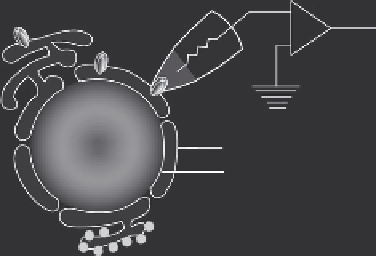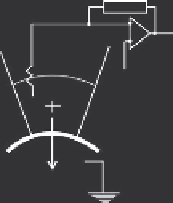Biology Reference
In-Depth Information
A
B
Debris
Nucleus
Nucleoplasm
ONM
INM
Cell
Nucleus
10
m
m
+40 mV
C
D
PS
Cytosol
Lumen-out
BS
Lumen
K
+
ONM
INM
E
10 pA
IP
3
K
+
500 ms
On-nucleus
C
Cytoplasm-out
Fig. 2
Nuclear patch-clamp recording of IP
3
R. (A) The nuclear envelope comprises an inner (INM)
and outer (ONM) membrane surrounding a luminal space that is continuous with the lumen of the ER.
The continuity of the ONMwith the ERmembrane allows some ER proteins to invade the ONM, where
they become accessible to nuclear patch-clamp recording. (B) Phase-contrast image of a DT40 nuclear
preparation showing nuclei, one of which has debris attached, and an intact cell. (C) Three recording
configurations are used for nuclear patch-clamp recording. The on-nucleus, lumen-out, and cytosol-out
excised patch configurations are analogous to the cell-attached, inside-out, and outside-out configura-
tions of conventional patch-clamp recording (
Fig. 1
B). (D) An excised lumen-out nuclear patch
illustrating the convention used to report membrane potential. (E) Typical recording from a single
IP
3
R3 recorded in the lumen-out configuration from the nucleus of a DT40-KO cell stably expressing
rat IP
3
R3. PS included IP
3
(10
m
M), ATP (5 mM), and a free [Ca
2
þ
]of
200 nM; K
þ
was the charge
carrier and the holding potential was
þ
40 mV. C denotes the closed state.
to analyses of di
erent cells, including COS-7
cells (
Boehning et al.,2001a
), insect Sf9 cells (
Ionescu et al.,2006
), smooth muscle
(
Kusnier et al.,2006
), DT40 cells (
Betzenhauser et al.,2009b;Delliset al.,2006;
V
erent IP
3
R subtypes expressed in di
V





















